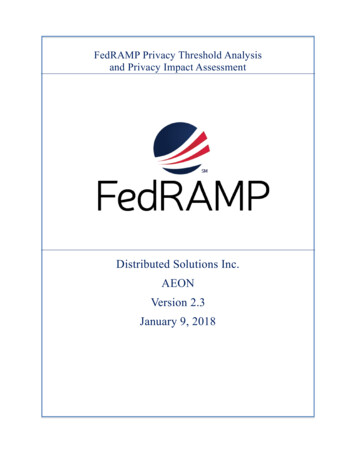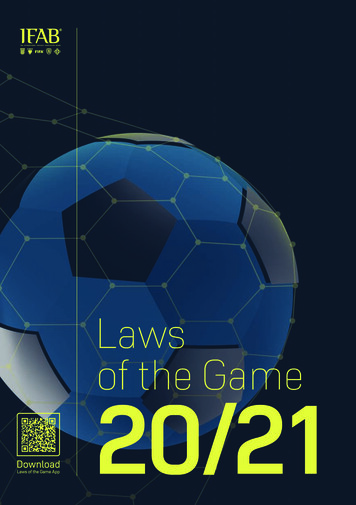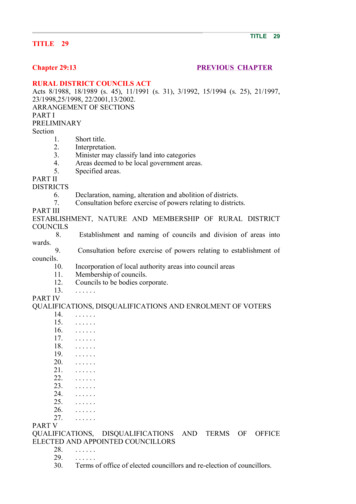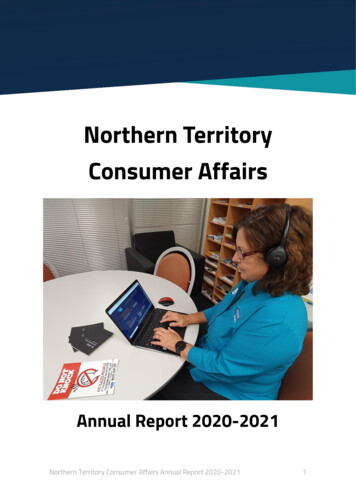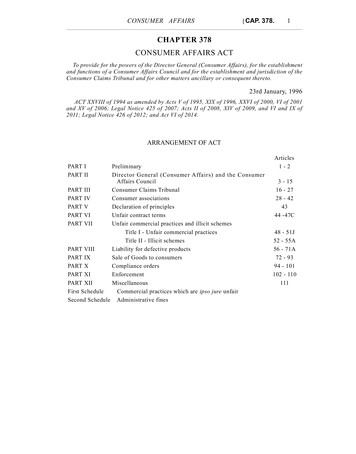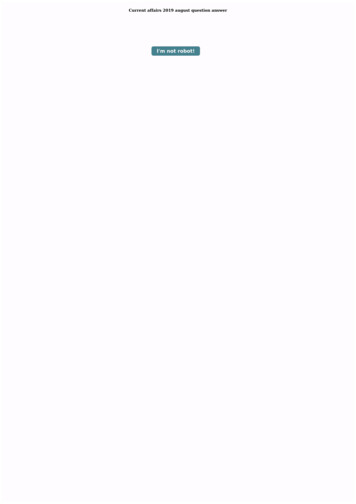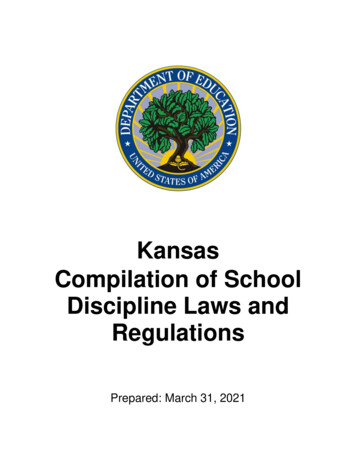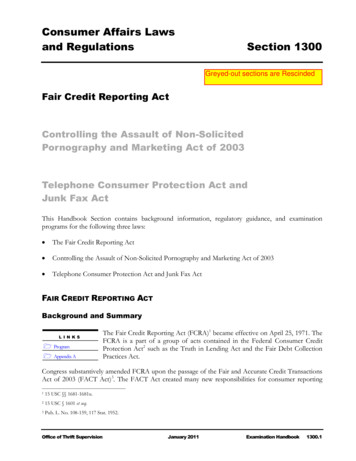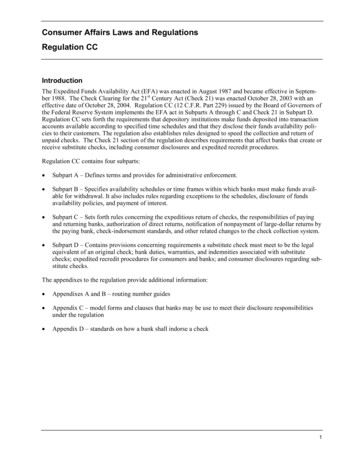
Transcription
Consumer Affairs Laws and RegulationsRegulation CCIntroductionThe Expedited Funds Availability Act (EFA) was enacted in August 1987 and became effective in September 1988. The Check Clearing for the 21st Century Act (Check 21) was enacted October 28, 2003 with aneffective date of October 28, 2004. Regulation CC (12 C.F.R. Part 229) issued by the Board of Governors ofthe Federal Reserve System implements the EFA act in Subparts A through C and Check 21 in Subpart D.Regulation CC sets forth the requirements that depository institutions make funds deposited into transactionaccounts available according to specified time schedules and that they disclose their funds availability policies to their customers. The regulation also establishes rules designed to speed the collection and return ofunpaid checks. The Check 21 section of the regulation describes requirements that affect banks that create orreceive substitute checks, including consumer disclosures and expedited recredit procedures.Regulation CC contains four subparts: Subpart A – Defines terms and provides for administrative enforcement. Subpart B – Specifies availability schedules or time frames within which banks must make funds available for withdrawal. It also includes rules regarding exceptions to the schedules, disclosure of fundsavailability policies, and payment of interest. Subpart C – Sets forth rules concerning the expeditious return of checks, the responsibilities of payingand returning banks, authorization of direct returns, notification of nonpayment of large-dollar returns bythe paying bank, check-indorsement standards, and other related changes to the check collection system. Subpart D – Contains provisions concerning requirements a substitute check must meet to be the legalequivalent of an original check; bank duties, warranties, and indemnities associated with substitutechecks; expedited recredit procedures for consumers and banks; and consumer disclosures regarding substitute checks.The appendixes to the regulation provide additional information: Appendixes A and B – routing number guides Appendix C – model forms and clauses that banks may be use to meet their disclosure responsibilitiesunder the regulation Appendix D – standards on how a bank shall indorse a check1
Regulation CCSubpart A General DefinitionsThe term “bank” refers to all banks, mutual savings banks, savings banks and savings associations that areinsured by the FDIC, and federally-insured credit unions. “Bank” also refers to non-federally insured banks,credit unions and thrifts, as well as agencies and branches of foreign banks and Federal Home Loan Bank(FHLB) members. For purposes of subparts C and D, “bank” also includes any person engaged in the business of banking, Federal Reserve Banks, FHLBs, and state/local governments to the extent that the government unit pays checks. For purposes of subpart D only, “bank” also refers to the U.S. Treasury and theUnited States Postal Service (USPS) to the extent that they act as payors. The term “paying bank” refers to any bank at which or through which a check is payable and to which itis sent for payment or collection. For purposes of subpart D, “paying bank” also includes the U.S.Treasury and USPS. The term “paying bank” also includes the Federal Reserve Banks, FHLBs,state/local governments, and, if a check is not payable by a bank, the bank through which a check is payable. A “reconverting bank” is the bank that creates a substitute check or is the first bank to transfer or present a substitute check to another party.The term “check” includes both original checks and substitute checks.1 An “original check” is the first paper check issued with respect to a particular payment transaction. A “substitute check” is a paper reproduction of an original check that:–Contains an image of the front and back of the original check;–Bears a MICR line containing all of the information encoded on the original check’s MICR line, except as provided in the industry standard for substitute checks; 2–Conforms in dimension, paper stock, and otherwise with industry standards for substitute checks;and–Is suitable for automated processing in the same manner as the original check.A substitute check for which a bank has provided the warranties described in §229.52 is the legal equivalent of an original check if the substitute check accurately represents all of the information on the frontand back of the original check and bears the legend “This is a legal copy of your check. You can use itthe same way you would use the original check.” A “copy” of an original check is any paper reproduction of an original check, including a paper printoutof an electronic image, a photocopy, or a substitute check. A “sufficient copy” is a copy of an original1 The term “check” does not include checks drawn in a foreign currency or checks drawn on a bank located outside theUnited States.2 Magnetic ink character recognition (MICR) line means the numbers, which may include the routing number, accountnumber, check number, and check amount, that are printed across the bottom of a check in magnetic ink. The industrystandard for substitute checks is American National Standard Specifications for an Image Replacement Document –IRD, X9.100-140. ANS X9.100-140 specifies ways in which the content of a substitute check’s MICR line may varyfrom the content of the original check’s MICR line. ANS X9.100-140 also specifies circumstances in which a substitute check MICR line need not be printed in magnetic ink.2
Regulation CCcheck that accurately represents all of the information on the front and back of the check at the time oftruncation or is otherwise sufficient to establish the validity of a claim.The term “truncate” means to remove an original check from the forward collection or return process andreplace it with a substitute check or, by agreement, information relating to the original check. The truncatingbank may or may not choose to provide subsequent delivery of the original check.A “local” check is a check deposited in a location of the depository bank that is located in the same FederalReserve check processing region as the paying bank. A “non-local” check is a check deposited in a differentcheck processing region than the paying bank.An “account” for purposes of subparts B and C is a “deposit” as defined in 12 CFR 204.2(a)(1)(i) that is a“transaction account” as defined in 12 CFR 204.2(e) (12 CFR 204 is the Federal Reserve Board’s RegulationD). It encompasses consumer and corporate accounts and includes accounts from which the account holderis permitted to make transfers or withdrawals by: Negotiable instrument; Payment order of withdrawal; Telephone transfer; or Electronic payment.However, for the purpose of subpart B, “account” does not include accounts where the account holder is abank or a foreign bank, or where the account holder is the Treasury of the United States.For the purpose of subpart D, “account” means any deposit at a bank, including a demand deposit or othertransaction account and a savings deposit or other time deposit. Many deposits that are not accounts for purposes of the other subparts of Regulation CC, such as savings deposits, are accounts for purposes of subpartD.A “consumer” means a natural person who draws a check on a consumer account or cashes or deposits areturned check against a consumer account.A “consumer account” means an account used primarily for personal, family, or household purposes.A “customer” means a person who has an account with a bank.“Business day” and “banking day” are defined as follows: “Business day”-any day excluding Saturdays, Sundays and legal holidays (standard Federal Reserveholiday schedule). “Banking day”-a business day in which a bank is open for substantially all of its banking activities.Even though a bank may be open for regular business on a Saturday or Sunday, it is not a banking day forthe purpose of Regulation CC because Saturday and Sunday are never a 'business day' under the regulation.The fact that one branch is open to the public for substantially all of its banking activities does not necessarily mean that day is a banking day for other branches.3
Regulation CCAdministrative Enforcement §229.3The regulation is to be enforced for banks through Section 8 of the Federal Deposit Insurance Act (12 U.S.C.1818) and for credit unions through the Federal Credit Union Act (12 U.S.C. 1751 et seq.). In addition, a supervisory agency may enforce compliance though any other authority conferred on it by law. The FederalReserve Board shall enforce the requirements of the regulation for depository institutions that are not specifically committed to some other government agency.Subpart B Availability of Funds And Disclosure of Funds AvailabilityPoliciesNext-Day Availability §229.10Cash, electronic payments, and certain check deposits must generally be made available for withdrawal thebusiness day after the banking day on which they were received. Among the covered check deposits arecashier's, certified, and teller's checks, government checks (including U.S. Treasury checks, U.S. Postalmoney orders, state and local government checks, checks drawn on Federal Reserve or Federal Home LoanBanks), and certain “on us” checks (checks drawn on the same bank or a branch thereof).Generally, to qualify for next-day availability, the deposit must be: Made at a staffed teller station; and Deposited into an account held by the payee of the check.However, two types of deposits, U.S. Treasury checks and “on us” checks, must receive next-day availabilityeven if the deposit is not made at a staffed teller station. Other next-day check deposits, and cash deposits,that are not made at staffed teller stations must be available for withdrawal on the second business day afterthe day of deposit under §229.10(a)(2) and §229.10(c)(2).Additional RulesUnder §229.10(c)(1)(iv-v), for state and local government checks to receive next-day availability, the depository bank must be located in the same state as the governmental unit issuing the check. Further, under§229.10(c)(3), the depository bank may require special deposit slips or envelopes for these deposits, as wellas for cashier's, certified and teller's check deposits. If the depository bank requires the use of special depositslips, it must either provide the slips or inform customers how they may be obtained.For “on us” checks to receive next-day availability, the checks must be drawn on the same or another branchof the bank where the check is deposited. In addition, both branches must be located in the same state orcheck processing region. 100 RuleSection 229.10(c)(1)(vii) of the regulation contains a special 100 rule for check deposits not subject to nextday availability. Under the rule, the depository bank must make available for withdrawal the lesser of 100or the aggregate amount deposited to all accounts, including individual and joint accounts, held by the samecustomer on any one banking day. The 100 rule does not apply to deposits received at nonproprietaryATMs.4
Regulation CCAvailability Schedule §229.12The permanent availability schedule became effective on September 1, 1990. (See Permanent Funds Availability Schedule-Figures A & B). Under this schedule local check deposits must be made available no laterthan the second business day following the banking day of deposit. Deposits of nonlocal checks must bemade available no later than the fifth business day following the banking day of deposit. Funds, includingcash and all checks, deposited at nonproprietary ATMs must be made available no later than the fifth business day following the banking day on which the funds were deposited.Checks that would normally receive next-day availability are treated as local or non-local check deposits ifthey do not meet all the criteria for next-day availability under §229.10(c). (As mentioned earlier, certainchecks generally deposited at a staffed teller station and into an account held by the payee of the check receive next-day availability. However, state, local government and certain “on us” checks are subject to additional rules).U.S. Treasury checks and U.S. Postal Money orders that do not meet all the requirements for next-day orsecond day availability as outlined in §229.10(c) receive funds availability as if they were “local” checks.Cashiers, certified, teller's, state and local government and checks drawn on the Federal Reserve or FederalHome Loan Banks that do not meet all the requirements in §229.10(c), receive funds availability as eitherlocal or non-local checks, according to the location of the bank on which they are drawn.Cash WithdrawalsSpecial rules apply to cash withdrawals from local and non-local check deposits. While §229.12 (d) allowsthe depository bank to extend the availability schedule for cash or similar withdrawals by one day, the customer must still be allowed to withdraw the first 100 of any check deposit not subject to next-day availability on the business day following the day of deposit. In addition to the first 100, a customer must also beallowed to withdraw 400 of the deposited funds (or the maximum amount that can be withdrawn from anATM, but not more than 400) no later than 5 p.m. on the day funds become available for check withdrawals. The remainder of deposited funds would be available for cash withdrawal on the following business day.Extension of the Schedule for Certain DepositsSection 229.12(e) provides that banks in Alaska, Hawaii, Puerto Rico, or the Virgin Islands receiving checksdrawn on or payable through banks located in another state may extend the availability schedules for localand non-local checks by one day. This exception, however, does not apply to checks drawn on banks in thesestates or territories and deposited in banks located in the continental U.S.5
Consumer Affairs Laws and RegulationsRegulation CCPermanent Funds Availability SchedulesFigure AIllustrates availability of different types of checks deposited the same day, under the schedules.Monday(Day 0)Tuesday(Day 1)LocalWednesday(Day 2)1Thursday(Day 3)Friday(Day 4)Monday(Day 5)Tuesday(Day 6)Wednesday Thursday(Day 7)(Day 8)Deposit2 100 900Cash 1,0001Check4 100 4005 500Nonlocal13 100 900 1,00014 100 4005 5001 The first 100 of a day’s deposit must be made available for either cash withdrawal or check writing purposes at the start of thenext business day § 229.10(c)(1)(vii).2 Local checks must be made available for check writing purposes by the second business day following deposit § 229.12(b).3 Nonlocal checks must be made available for check writing purposes by the fifth business day following deposit § 229.12(c).4 400 of the local deposit must be made available for cash withdrawal no later than 5:00 p.m. on the day specified in theschedule. This is in addition to the 100 that must be made available on the business day following deposit § 229.12(d).5 The remainder of the deposit must be made available for cash withdrawal at the start of business the following day§ 229.12(d).6
Regulation CCPermanent Funds Availability SchedulesFigure BIllustrates availability of different types of checks deposited on separate days, under the schedules.Monday(Day 0)Tuesday(Day 1)Wednesday(Day 2)Thursday(Day 3)Friday(Day 4)LocalMonday(Day 5)1Tuesday(Day 6)Thursday(Day 8)Deposit2 100Wednesday(Day 7) 900Cash Withdrawals 1,000Check Writing1 10045 400 1,4001Nonlocal 100 1,00013 100 9001 The first 100 of a day’s deposit must be made available for either cash withdrawal or check writing purposes at the start of thenext business day § 229.10(c)(1)(vii).2 Local checks must be made available for check writing purposes by the second business day following deposit § 229.12(b).3 Nonlocal checks must be made available for check writing purposes by the fifth business day following deposit § 229.12(c).4 400 of the local deposit must be made available for cash withdrawal no later than 5:00 p.m. on the day specified in theschedule. This is in addition to the 100 that must be made available on the business day following deposit § 229.12(d).5 The remainder of the deposit must be made available for cash withdrawal at the start of business the following day § 229.12(d).7
Consumer Affairs Laws and RegulationsRegulation CCExceptions §229.13The regulation provides six exceptions that allow banks to exceed the maximum hold periods in the availability schedules. The regulation regards the exceptions as “safeguards” to the maximum availability timeframes because they are intended to offer the institution a means of reducing risk based on the size of the deposit, past performance of the depositor, lack of depositor performance history, or belief that the deposit maynot be collectible. These exceptions include: New accounts; Deposits in excess of 5,000 on any one day; Checks that have been returned unpaid and are being redeposited; Deposits to accounts that have been repeatedly overdrawn; Cases in which the bank has a reasonable cause to believe the check being deposited is uncollectable;and Emergency conditions.While banks may exceed the time frames for availability in these cases, the exceptions may generally not beinvoked if the deposit would ordinarily receive next-day availability.New Accounts ExceptionAn account is considered a “new account” under §229.13(a) for the first 30 days after it is established. Anaccount is not considered “new” if each customer on the account had another established account at the bankfor at least 30 calendar days. The new account exception applies only during the 30-day period, beginning onthe date the account is established, and does not cover all deposits made to the account.Although the regulation exempts new accounts from the availability schedules for local and non-localchecks, next-day availability is required for deposits of cash and for electronic payments. Additionally, thefirst 5,000 of a day's aggregate deposits of government checks (including federal, state, and local governments), cashier's, certified, teller's, depository or traveler's checks must be given next-day availability. Theamount in excess of 5,000 must be made available no later than the ninth business day following the day ofdeposit.To qualify for next-day availability, deposits into a new account must generally be made in person to an employee of the depository bank. If the deposits are not made in person to an employee of the depository bank,such as an ATM deposit, availability may be provided on the second business day after the day of deposit.U.S. Treasury check deposits, however, must be given next-day availability regardless of whether they aremade at staffed teller stations or proprietary ATMs. Banks are not required to make the first 100 of a day'sdeposits of local and non-local checks or funds from “on us” checks available on the next business day.Large Deposit Exception (Deposits over 5,000)Under §229.13(b), the large deposit exception, a depository bank may extend hold schedules when depositsother than cash or electronic payments exceed 5,000 on any one day. A hold may be applied to the amount8
Regulation CCin excess of 5,000. To apply the rule, the depository bank may aggregate deposits made to multiple accounts held by the same customer, even if the customer is not the sole owner of the accounts.Redeposited Check ExceptionUnder §229.13(c), the depository bank may delay the availability of funds from a check if the check had previously been deposited and returned unpaid. This exception does not apply to checks that were previouslyreturned unpaid because of a missing indorsement or because the check was postdated when presented.Repeated Overdraft ExceptionSection 229.13(d), provides that if a customer's account, or accounts, have been repeatedly overdrawn duringthe preceding six months, the bank may delay the availability of funds from checks. A customer's accountmay be considered “repeatedly overdrawn” in two ways. First, the exception may be applied if the account(or accounts) have been overdrawn, or would have been overdrawn had checks or other charges been paid,for six or more banking days during the preceding six months.Second, the exception may be applied to customers who incur overdrafts on two banking days within the preceding six month period if the negative balance in the account(s) is equal to or greater than 5,000. This exception may also apply if the account would have been overdrawn by 5,000 or more had checks or othercharges been paid.Reasonable Cause to Doubt Collectability ExceptionThis exception, in §229.13(e), may be applied to all checks. To trigger this exception, the depository institution must have “reasonable cause” to believe that the check is not collectible and must disclose the basis forthe extended hold to the customer. For example, reasonable cause may include communication with the paying bank indicating that: There has been a stop payment placed on the check; There are insufficient funds in the drawer's account to cover the check; or The check will be returned unpaid.The “reasonable cause” exception may also be invoked in cases where: The check is deposited six months after the date of the check (stale date); The check is postdated (future date); The depository bank believes that the depositor may be engaged in check kiting.The “reasonable cause” exception may not be invoked because of: The race or national origin of the depositor; or The fact that the paying bank is located in a rural area and the depository bank will not have time to learnof nonpayment of the check before the funds have to be made available under the availability schedulesin place.9
Regulation CCWhenever this exception is used, the bank must notify the customer, in writing, at the time of deposit. If thedeposit is not made in person or the decision to place the hold is based on facts that become known to thebank at a later date, the bank must mail the notice by the first business day after the day the deposit is madeor the facts become known. The notice must indicate that availability is being delayed and must include thereason that the bank believes the funds are uncollectable. If a hold is placed on the basis of confidential information, as when check kiting is suspected, the depository bank need only disclose to the customer that thehold is based on confidential information that the check may not be paid.If the bank asserts that the hold was placed due to confidential information, the bank must note the reason onthe notice it retains as a record of compliance. The depository bank must maintain a record of each exceptionnotice for a period of two years. This record should contain a brief description of the facts or any documentssupporting the “reasonable cause” exception.Overdraft and Returned Check FeesUnder §229.13(e)(2), if a depository bank invokes the “reasonable cause” exception and does not inform thecustomer in writing at the time of the deposit, the bank may not charge the customer any overdraft or returned check fees resulting from the hold if: The deposited check is paid by the paying bank; and The overdraft or returned check would not have occurred had the depository bank not imposed the reasonable cause hold.However, the depository bank may assess overdraft or returned check fees if, on the exception hold notice, itstates that the customer may be entitled to a refund of any overdraft or return check fees imposed and describes how the customer may obtain such a refund. It must then refund the fees upon request.Emergency ConditionsSection 229.13(f) of the regulation also permits institutions to suspend the availability schedules under emergency conditions. Emergency situations include: Any interruption of communication facilities; Suspension of payments by another depository institution; War; or Any emergency condition beyond the control of the receiving depository institution.Notice of ExceptionWhenever a bank invokes one of the exceptions (excluding new accounts) to the availability schedules, itmust notify the customer in writing in accordance with §229.13(g). Banks may send notices that complysolely with §229.13(g)(1), or may comply with two alternative notice requirements discussed below.General Notice RequirementsBanks complying with §229.13(g)(1) must send notices which include:10
Regulation CC The customer's account number; The date and amount of the deposit; The amount of the deposit that will be delayed; The reason the exception was invoked; and The day the funds will be available for withdrawal (unless unknown, as in an emergency situation).If the deposit is made at a staffed facility, the written exception notice may be given to the person making thedeposit regardless of whether the “depositor” is the customer who holds the account. If the deposit is notmade at a staffed facility, the exception notice may be mailed to the customer no later than the business dayfollowing the banking day of deposit. If however, the depository bank discovers a reason to delay the funds,subsequent to the time the notice should have been given, the bank must notify the customer of the hold assoon as possible, but not later than the business day after the facts become known. In certain instances, exception holds based on “emergency” situations do not require notification to customers. For example, if deposited funds, subject to holds placed during an “emergency”, become available for withdrawal before thenotices are required to be sent, the depository bank is not required to send the notices to its customers.Exception Notice for Nonconsumer AccountsIf most check deposits to a nonconsumer account permit the bank to invoke either the large dollar or redeposited check exception, the bank may send a notice complying with §229.13(g)(1), or may send a one-timenotice in accordance with §229.13(g)(2). The one-time notice must be sent when the first exception is invoked, or can be delivered before that time. The notice must state: The reason the exception may be invoked; and The time period when the funds will generally be made available.Exception Notice for Repeated OverdraftsIf most check deposits to an account permit the bank to invoke the repeated overdraft exception, the bankmay send a notice complying with §229.13(g)(1), or may send a notice in accordance with §229.13(g)(3).The notice must be sent when the overdraft exception is first invoked. The notice must state: The customer's account number; The fact that funds are being delayed because the repeated overdraft exception will be invoked; The time period the exception will be invoked; and The time period when the funds will generally be made available.Availability of Deposits Subject to ExceptionsFor exceptions (other than new accounts), §229.13(h) allows the depository bank to delay availability for a“reasonable” time beyond the schedule. Generally, a “reasonable” period will be considered to be no morethan one business day for “on-us” checks, five business days for local checks and six business days for nonlocal checks. If a depository bank extends its availability beyond these time frames, it must be able to provethat such a delay is “reasonable”.11
Regulation CCPayment of Interest §229.14General RuleA depository bank must begin accruing interest on interest-bearing accounts no later than the business day onwhich it receives provisional credit for the deposited funds. A depository bank typically receives credit onchecks within one or two days following deposit. A bank receives credit on a cash deposit, an electronic payment, and a check that is drawn on itself on the day the cash, check or electronic payment is received. If anonproprietary ATM is involved, credit is usually received on the day the bank that operates the ATM credits the depository bank for the amount of deposit.Section 229.14(a)(1) permits a bank to rely on the availability schedule from its Federal Reserve Bank, Federal Home Loan Bank, or correspondent bank to determine when the depository bank receives credit. Ifavailability is delayed beyond what is specified in the schedule, a bank may charge back interest, erroneouslypaid or accrued, on the basis of that schedule.Section 229.14(a)(2) permits a depository bank to accrue interest on checks deposited to all of its interestbearing accounts based on an average of when the bank receives credit for all checks sent for payment orcollection. For example, if a bank receives credit on 20 percent of the funds deposited by check as of thebusiness day of deposit (e.g., “on us” checks), 70 percent as of the business day following deposit, and tenpercent on the second business day following deposit, the bank can apply these percentages to determine theday interest must begin to accrue for check deposits on all interest-bearing accounts, regardless of when thebank received credit for funds deposited in any particular account. Consequently, a bank may begin accruinginterest on a uniform basis for all interest-bearing accounts, without having to track the type of check deposited to each account.Nothing in §229.14(a) limits a depository bank policy that provides that interest can only accrue on balancesthat exceed a specified amount, or on the minimum balance maintained in the account during a given period.However, the balance must be determined according to the date the depository bank receives credit for thefunds. This section also does not limit any policy providing that interest can accrue sooner than required bythe regulation.Money market deposit accounts, savings deposits, and time deposits, are not subject to the general rule concerning the timing of interest payment. However, for simplicity of operation, a bank may accrue interest onsuch deposits in the same manner that it accrues interest on transaction accounts.Exemption for Certain Credit UnionsSection 229.14(b) contains an exemption from the payment
A "consumer account" means an account used primarily for personal, family, or household purposes. A "customer" means a person who has an account with a bank. "Business day" and "banking day" are defined as follows: "Business day"-any day excluding Saturdays, Sundays and legal holidays (standard Federal Reserve
